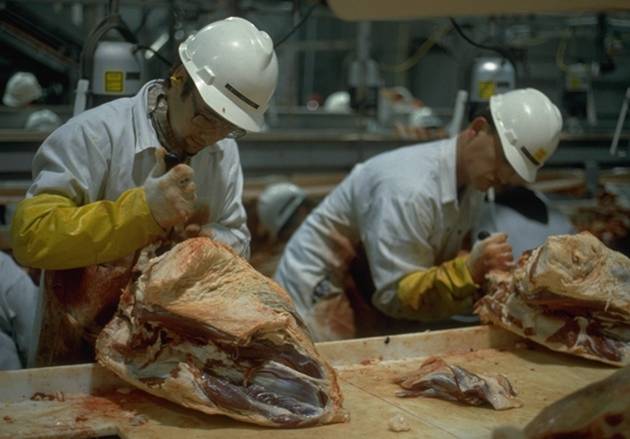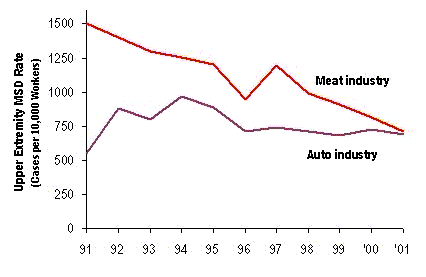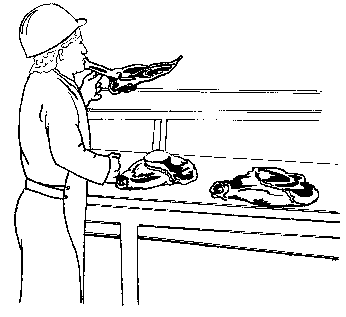Ergonomics
Success in Meatpacking
What
YOU can learn from this experience
Dan MacLeod
www.danmacleod.com
Based on a presentation at the National Ergonomics Exposition
April 10,
1996, Chicago, Illinois.

Even if you
don't kill hogs and steers for a living, you can learn from the slaughter
industry
Background
The meatpacking industry has clearly had the highest rates of upper
extremity musculoskeletal disorders (MSDs). Meatpacking has
been affected by this problem because (a) a high percentage of this workforce does
repetitive hand and arm work, and (b) there are severe engineering constraints on
equipment development due to the random shapes of the products and the strict sanitation
requirements.
Because of the high MSD rate, the industry has been the focus of much regulatory and
media attention. In the 1980’s, OSHA fined a number of meat and poultry companies in
a series of highly publicized actions.
In 1990, the meat industry and OSHA instituted industry-wide programs to address the
MSD problem systematically. In particular, OSHA published its Ergonomics Guidelines for
the Meatpacking Industry developed in conjunction with the American Meat Institute
(AMI). The meat industry thus is serving in many ways as a testing ground for determining
effective ways to prevent CTDs.
The meatpacking ergonomics guidelines — only a few pages long plus some appendices
— encouraged management commitment as evidenced by a written program, employee
involvement, and regular program review and evaluation. The guidelines are further divided
into four program elements:
I. Worksite Analysis
II. Hazard Prevention and Control
III. Medical Management
IV. Training
During the meetings between OSHA and the AMI to develop these guidelines, OSHA laid out
their expectations in two important ways:
1. The overall thrust of the guidelines were what was most important, and,
2. The details of the guidelines were not items that every company had to
institute in all minute particulars.
[Note: Later a number of individual inspectors and area directors reneged on this
agreement, which calls into question
basic premises about the potential OSHA ergonomics standard.]
OSHA’s primary request was that management develop good faith efforts to address
the MSD issues and implement certain key activities. OSHA made it clear in these meetings
with the industry that the guidelines were intended to be adapted to the needs and
resources of each employer. OSHA officials used the term "menu" to describe
aspects of each of the above key elements, stating they were ideas to consider and choose
from as each company considered appropriate.
MSD Rates — Meat Industry Decrease

Bureau of Labor Statistics, 1991-1996
These figures provide evidence that the employer ergonomics programs in this industry
are working, and that OSHA’s Ergonomics Guidelines for the Meatpacking Industry
are having a positive impact.
Cost savings
Data from individual meatpacking companies indicate significant cost savings from
ergonomics programs and related administrative and medical management changes. The two big
sources of cost savings have generally been in workers’ compensation, and in the
reduction of costly turnover. Unfortunately, I am not aware of any industry-wide data.
What changes did they make?
An important lesson is that many of the improvements came from low tech changes and
doing the basics, NOT from buying capital intensive machines or automation (although there
has been some of that).
A good example lowering the heights of overhead conveyors. It had been standard
practice in the industry (as well as in other industries) to throw scrapped product on
takeaway conveyors that were over head height. As a result, many employees were having
problems with their shoulders.


|
Before: very high |
After: lower |
The first realization was that they conveyors really did not need to be as high as they
were. It was possible in many cases to lower these conveyors considerably (these
modifications were not necessarily inexpensive because the conveyors were often
inter-linked in a whole system of material handling). Subsequently, engineers have
discovered ways to place these conveyors underneath or to the sides of the cutting lines,
so that everything is tossed downward, rather than upward. It has taken some creative
thinking, but it was all low tech stuff.
The following itemizes some of the other types of changes:
Ways to reduce exertion
Tumblers — Hams are placed in large tumblers (somewhat like cement mixers) which
softens them up to be easier to cut.
Improved coolers — Changes in how the sides of beef or pork are stored in cold
meat lockers helped insure that the meat was not frozen when it was cut up.
Fixtures — A variety of innovative fixtures have been developed to reduce strain
on the "holding hand." Many of these fixtures are simple hooks.
Mechanical assists — A variety of powered assists have been invented to eliminate
high exertion tasks, such as pulling apart meat from bone, or removing the hides, or
inserting core samplers into bins of ground meat.
Cart design — Larger wheels, better floor, adding grips to carts, and using
various types of powered tuggers have all help reduce the force needed to move carts
around.
Training — Improved training programs have helped employees to keep their knives
sharp and to use the best work techniques.
Ways to improve posture, heights and
reaches
Adjustable tables — To accommodate employees of various heights, work surfaces
have been designed to adjust in height, some even at the push of a button.
Adjustable stands — When it was not possible to adjust the work surfaces, the
meatpacking companies improved the types of stands that were available to permit height
adjustments, some involving hooks and racks that needed to be lifted up and down by hand,
others adjusted by hand cranks, and yet others at the push of a button. (One of the most
sophisticated adjustable stands that exists in industry had been invented years ago in
meatpacking — the splitting platform, which moves up and down the height of a hanging
side of beef, plus simultaneously moves sideways to following the moving conveyor chain;
other industries can learn from this technique.)
Tub tilters — It had been common to work bending over into various types of tubs;
now devices that raise up and tilt these tubs are available and being phased into
operations.
Tilted work surfaces — Some conveyor cutting lines have been tilted to enable
workers to work in more upright postures.
Pistol-grip knives — Unconventional knives have been invented that have angled
grips that put wrists in better postures. These types of knives
had much less application than anticipated, but they helped to
challenge stereotypes about how knives are supposed to look.
Height changes — Countless work surfaces have been modified, including lips and
barriers between various pieces of equipment that created extra work.
Ways to reduce repetitive motions
Sliding — Ways have been found to slide products, rather than lift them.
Motion efficiency — Layout changes have resulted in improved.
Knife and tool redesign
Grips — Knife and cutting tool manufacturers have responded to the needs of
the industry and developed improved knife grips: unconventional shapes, multi-sized, and
even modular grips.
Straps — Manufacturers have also added straps to fixture the tool to the hand, and
thus reduce static gripping.
Standing
Lean stands — Most packers have experimented with providing lean stands on
cutting lines (with mixed success).
Cushioned grating — Since it is difficult to use anti-fatigue mats the concrete
floors in this environment where sanitation is such an issue, some packing plants have
placed fiberglass grating on mounts about ½ inch off the floor, which then provides
sufficient cushion.
Automation
Disappointments — Despite some initial promise, many efforts to develop
automatic cutting machines have stalled. The difficulties are the sanitation requirements,
plus the fact that the products are all randomly shaped.
Successes — In some cases though, machinery has succeeded. An example is using
presses to squeeze meat off beef neck bones, which eliminated an extremely repetitive hand
and wrist task. Another good example is new, automated ways to sort product, which has
eliminated tasks that involved repetitive elbow and shoulder movements.
Training
Hundreds of pairs of eyes — A clearly successful strategy has been not to rely
just on experts to identify improvements; training plant teams to evaluate tasks and
brainstorm improvements has led to thousands of feasible ideas.
An atmosphere of creativity — By doing all of the above and teaching techniques on
how to innovate, an atmosphere of creativity has been created in many companies, where the
brainstorming process and willingness to proceed with trial and error has become normal
business.
Involvement of the trade association
As a key part of the overall effort, the American Meat Institute (AMI — the
industry trade association) developed a comprehensive program in ergonomics to aid its
members. Few, if any, other industries can demonstrate an equivalent program involving as
coordinated an effort on an industry-wide basis.
Organization — The AMI Safety Committee, which is composed of member safety
directors took on a strong and active role to coordinate activities; engineers from
multiple companies routinely met to share feasible ideas; equipment suppliers became
involved in the programs; virtually all AMI conferences addressed ergonomics in some way.
Training — the AMI developed industry-specific training materials, including
materials for both managers and employees, and including both booklets and videotapes; the
AMI held numerous regional and national conferences of safety and ergonomics;
Identifying Improvements — the trade association took multitudes of steps to
promote problem-solving, including the following actions:
-
Funded a study on optimal working postures through the University of Nebraska.
-
Funded expert ergonomics assessments, shared with the industry.
-
Met on several occasions with NIOSH scientists to discuss long term research needs.
-
Sponsored a meatpacking section meeting at the 1989 Human Factors Society Meeting.
-
Described ergonomic innovations at the 1990 National Safety Congress.
-
Funded a study on potential applications of new technology.
-
Monitored European equipment developments.
-
Promoted cooperative R&D efforts among member firms.
Implications and Commentary
The preceding examples provide compelling evidence for two basic points, and in turn, offer guidance
for general industry:
1. OSHA’s meatpacking guidelines have had their desired
positive effect.
2. It is apparent that short, general guidelines are sufficient
and that there is no need for long or overly-specific regulations.
Retrospect on the Meatpacking Guidelines
In 1990, during the deliberations between OSHA and the meat industry representatives,
there was in fact little disagreement over the broad thrust of what needed to be done
(despite public perceptions of industry recalcitrance at this point) . The industry’s concern related to the details in the
document, and whether some of the language could come back later to haunt them in a way
not intended during these meetings. Much of the apparent disagreement amounted simply to
writing style. OSHA responded by editing some of the language for the better, and by
explaining intent more clearly.
My own view is that the OSHA representatives were at their best when they explained
verbally what their expectations were for the industry, but that confusion invariably
occurred in the attempt to write it down. My suggestion at the time was for OSHA to write
down their expectations in a page or two, and avoid the tendency to educate and provide
background information on how to establish a workplace ergonomics program. My experience
since has strengthened that view.
(The only exception to my view has been the section on Medical Management, originally
part of the main document, but subsequently moved to the appendix. This section has indeed
provided good guidance to industry, since an overview of administrative issues related to
MSD medical issues had not been published elsewhere. The Meatpacking Guidelines
were circulated widely in all industries and occupational nurses everywhere found value in
reading this material, once it was clear that there was latitude in application.)
Enforcement of the guidelines has been appropriate for the most part, as I have
observed in my own personal involvement. OSHA has focused on the basic areas, not the
details. Employers have been free to establish their own systems and approaches as long as
they were justifiable.
The conclusion is that the Meatpacking Guidelines were, all in all, short and
broadly enforced. And they are working.
Conclusion
The experience of the meat industry shows that the industry’s efforts and
OSHA’s Meatpacking Guidelines are working.
The implication for the rest of industry is that ergonomics works and there is nothing
magical or mystical about how to make modifications (although not every problem can be
solved with ergonomics).
The implication for regulation is that guidelines of some type are needed to spur
general industry into action. However, the guidelines should be short and general, not
long, detailed, or complicated.
Indeed, a short, general standard is the only approach that is meaningful. Once details
begin to be added, they result in recommendations that are inappropriate for some
employers.
|
